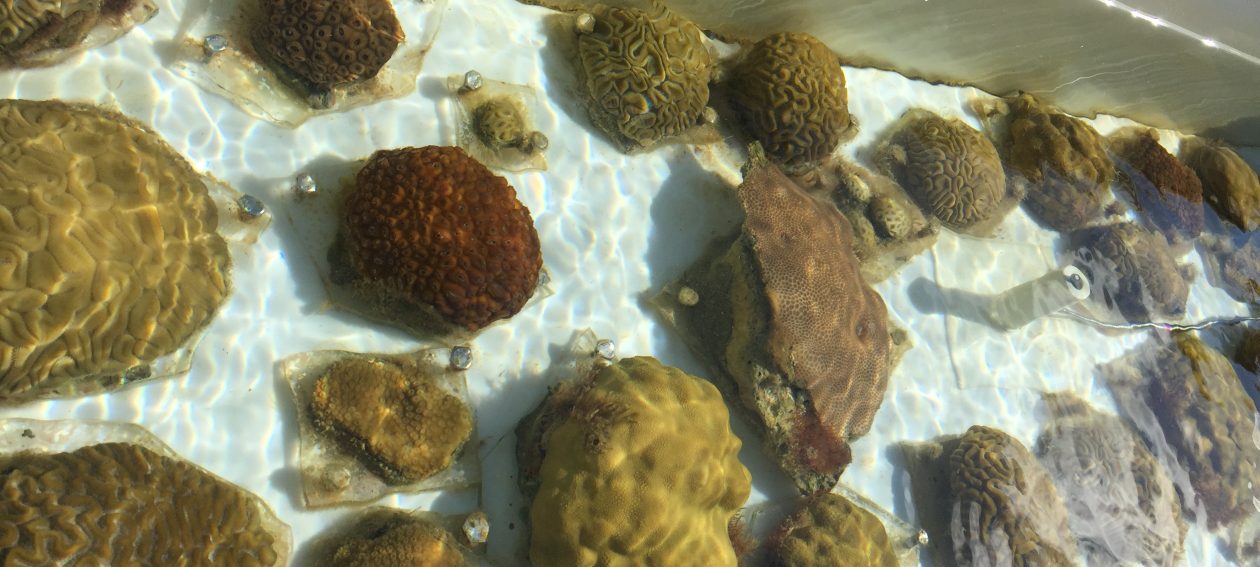Upper-mesophotic and shallow reef corals exhibit similar thermal
tolerance, sensitivity and optima
Link to a video presentation of this work at the:
Benthic Ecology Meeting 2022 in Portsmouth, NH
Abstract
The physiology of ectotherms living in marine
environments is strongly influenced by their local thermal
experience. Scleractinian corals living near their thermal
optimums are increasingly vulnerable to bleaching and
mortality as oceanic heat waves increases globally. Mesophotic
coral ecosystems (MCEs) below 30 m depths are
characteristically cooler than adjacent shallow water reefs,
which according to theory should result in differential
metabolic responses to temperature between depths. How
local temperatures influence physiological responses in
mesophotic corals is poorly understood. We compared
thermal sensitivities of four coral species between a shallow
(5–10 m) and upper-mesophotic (30-35 m) reef in
Bermuda. Thermal performance curves (TPC) were measured
in laboratory mesocosms for four common coral
species (Diploria labyrinthiformis, Orbicella franksi,
Montastraea cavernosa and Porites astreoides) across a
wide range of temperatures (19-36). Our results indicate
that the maximum rate of gross photosynthetic (GP) performance
(GP-Pmax) and the mean overall photosynthetic
rates (GP-lnc) varied significantly among species. In
contrast, thermal sensitivity (Pmax, Topt, lnc, E, Eh, or Th)
did not vary between depths for conspecifics except for
deactivation energy (GP-Eh) in D. labyrinthiformis.
Additionally, gross respiration (R) did not differ among
species or between depths for any thermal metric. Similar
metabolic responses between depths suggest that local
adaptation and/or acclimatization to different thermal
conditions is likely not occurring. Instead, upper-mesophotic
corals in Bermuda do not have lower bleaching
thresholds than shallow water conspecifics, but similar
thermal sensitivities supporting the potential for MCEs to
function as a thermal refuge.
Keywords Refuge Physiology Thermal performance
curves Thermal optimum Bermuda Climate change
Surprising spatiotemporal stability of a multi-peak fitness landscape revealed by independent field experiments measuring hybrid fitness
Abstract
The effect of the environment on fitness in natural populations is a fundamental question in evolutionary biology. However, experimental manipulations of both environment and phenotype at the same time are rare. Thus, the relative importance of the competitive environment versus intrinsic organismal performance in shaping the location, height, and fluidity of fitness peaks and valleys remains largely unknown. Here, we experimentally tested the effect of competitor frequency on the complex fitness landscape driving adaptive radiation of a generalist and two trophic specialist pupfishes, a scale-eater and molluscivore, endemic to hypersaline lakes on San Salvador Island (SSI), Bahamas. We manipulated phenotypes, by generating 3407 F4/F5 lab-reared hybrids, and competitive environment, by altering the frequency of rare transgressive hybrids between field enclosures in two independent lake populations. We then tracked hybrid survival and growth rates across these four field enclosures for 3–11 months. In contrast to competitive speciation theory, we found no evidence that the frequency of hybrid phenotypes affected their survival. Instead, we observed a strikingly similar fitness landscape to a previous independent field experiment, each supporting multiple fitness peaks for generalist and molluscivore phenotypes and a large fitness valley isolating the divergent scale-eater phenotype. These features of the fitness landscape were stable across manipulated competitive environments, multivariate trait axes, and spatiotemporal heterogeneity. We suggest that absolute performance constraints and divergent gene regulatory networks shape macroevolutionary (interspecific) fitness landscapes in addition to microevolutionary (intraspecific) competitive dynamics. This interplay between organism and environment underlies static and dynamic features of the adaptive landscape.
KEYWORDS: Adaptive dynamics, adaptive radiation, competition, key innovation, lepidophagy, negative frequency-dependent disruptive selection, novelty, trophic specialization
